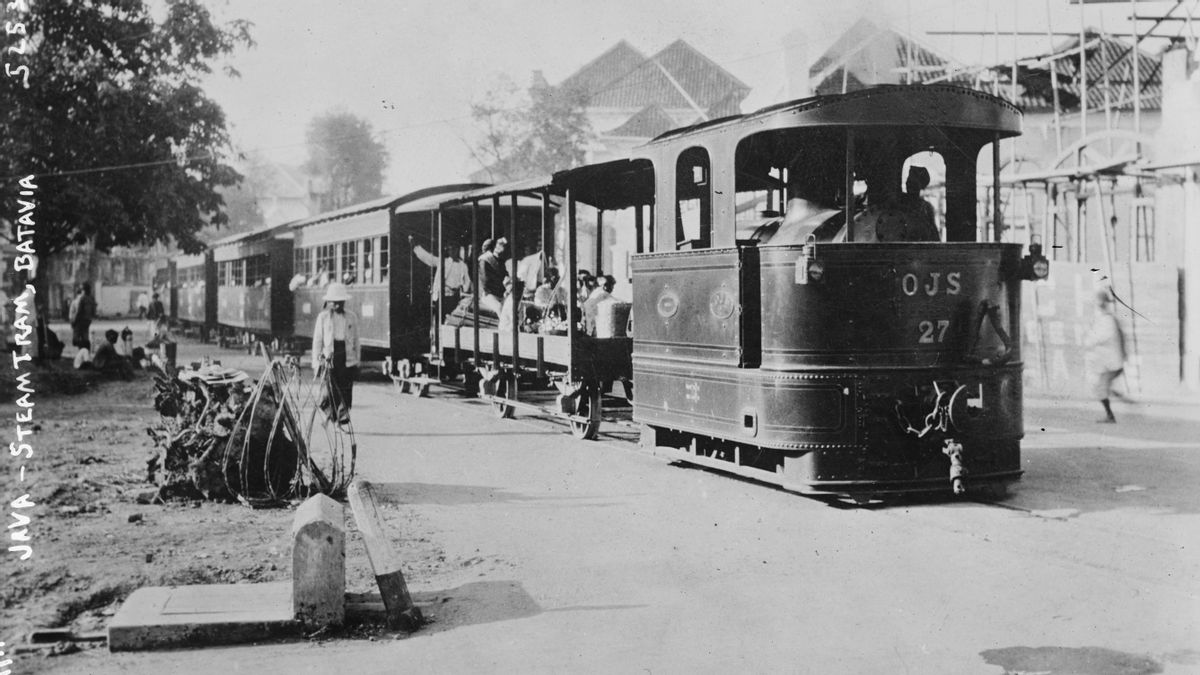JAKARTA - The tram mass transportation network was once the prima donna in Jakarta. After the horse-powered tram in 1869, the inhabitants of Batavia began to recognize the steam-powered tram since 1882. Instantly, the steam tram received a warm welcome in Batavia. Steam trams are even considered the most modern and deadliest means of public transportation of their time.
The existence of the steam tram is considered to be the successor to the existence of the horse tram which has many problems, ranging from being too slow, the problem of horses who are pooping, to the death of horses and racism in the tram cars. A full discussion can be read in the article on Horse Trams in Batavia: The Age of Horses Biting Iron to Death.
The series of problems became the beginning of the twilight of the horse tram. The Dutch government and the firm Dummler & Co. turn your brain to replace horse trams with steam tramway engines or commonly known as steam trams. The materials for the steam tram project were imported directly from the German factory Lokomotiv Fabrik Hohenzollern.
The author HJA Dufarc, in a book that discusses the history of trams in Batavia and Surabaya, Trams en Tramlijnen, De Elektrische Stadstrams op Java (1972), describes the initial stages of the steam tram presence. At that time the Company made use of the horse tram line. This lasted until all facilities were gradually replaced and completed in 1884.

However, the steam trams in Batavia were not like steam trams in other countries. If normally a steam tram locomotive was filled with water and then heated with a coal fire or wood fire to produce steam, the steam tram in Batavia consisted of a boiler called a remise.
At its base in Kramat, Remise is filled with steam which already has a certain pressure. Armed with this canned steam, the tram was strong enough to move on the "lijn" (route) from Kramat to Kota (Oud Batavia), then to Meester Cornelis (Jatinegara) and back again to its base to refuel with the canned steam.
Later, after the concession held by Dummler & Co. exhausted, a new company called Nederlandsch-Indische Tramweg Maatchappij (NITM) took over the position of the previous company. Under the operation of NITM, steam trams were transformed into the main mode of mass transportation in Batavia.
Every time the steam tram passed, the distinctive sound of the bell was deeply embedded in the memories of the citizens of Batavia. Above the locomotive, a bumiputra driver stood with an officer ready to light a fire. Usually the driver is accompanied by two uniformed bumiputra conductors, but barefoot. Meanwhile, the chief conductor is a European who is usually a retired soldier.
Class system on the steam tram
One of the things that makes steam trams attractive to the Dutch is the class division system. The distribution is done with different rates. This was absent from the previous horse trams, where all segments of society were mingled on one fare. The absence of a class system made it uncomfortable for Europeans to mingle with other ethnicities they considered beneath them.
For first class, NITM specializes in predominantly European passengers at a rate of 20 cents. Then, the second class was dominated by passengers who came from foreign easterners, such as Chinese, Arabs and Indians. Finally, the third class reserved for native Indonesians at a rate of only 10 cents. In one go, the steam tram can tow three carriages.
Even so, it was just a form of rule. In the field, a different scene is found. Moreover, from a distance the sound of steam tram bells greeted the citizens of Batavia. It is said that whoever is able to pay according to the price, the ticket owner is free to occupy the desired class on the steam tram.
“I heard that if they pay full rate, they can sit in first class or second class. But, of course, only the rich natives can afford to pay. The odd thing is that Chinese, Arabic, and European people are not allowed to sit in third grade. What is the reason I do not really know clearly, ”said HCC Clockener Brousson in the book Batavia Awal 20 (2017).
The Dutch soldier added that even though he was full-blooded Dutch, Clockener still did not agree with the rules for class division based on race. Therefore, Clockener did not hesitate to call the class division system only a form of the crazy racist prejudice that many Europeans in the Indies still adhere to.
“People in the Netherlands are only milkmaids, just because they don't have the beautiful brown skin like the natives, in the Indies they consider themselves extraordinary. Sometimes, I often have objections and often fight over that problem, ”he added.
NITM: This ride is sure to dieAlthough the residents of Batavia were applauded, the presence of the steam tram eventually presented various problems, especially in the rainy season. This is none other than because the innovation of canned steam is not a perfect invention. As a result, when it rains, the steam tram often breaks down because the canned steam has cooled.
Even in the dry season. The power from the steam power was sometimes insufficient to pull carriages across the Kramat bridge - the bridge connecting Kramat Bunder and Kwitang. As a result, Batavian residents often saw steam trams unable to cross the bridge.

However, the problem of trams breaking down is not that big compared to the problem of accidents caused by the presence of steam trams. The number of accidents caused by steam trams in Batavia is the highest. No kidding. The steam tram is dubbed as "the biggest killer roaming the city of Betawi."
"You see, one day he (steam tram) killed him every four hours. Betawi people like to joke around and then use the initials NITM to make fun of them: This Ride is Certainly Dead, ”written in an article entitled This Naik is Certainly Dead in the book" Ketoprak Jakarta "(2001).
Citizens of Batavia often voiced criticism regarding the recklessness of steam trams on the roads. One of the most famous criticisms came from the former Batavia Finance Inspector LWJ Olivier (1887-1890). According to him, there was no other company in the Indies that shed so much human blood.
"There will never be a second company in the Dutch East Indies that sheds human blood and still demands more like the Betawi steam tram, not counting the financial losses incurred by private parties such as horses, carriages, and others," said Olivier. .
The Company and NITM did not respond to this criticism. The existence of steam trams lasted for 50 years. In the end, the steam tram actually met its end on September 30, 1933. The reason was that the mass transportation network of the trams at that time began to adopt new technology, namely the electric-powered tram. Not because of the mounting problems steam trams cause.
The English, Chinese, Japanese, Arabic, and French versions are automatically generated by the AI. So there may still be inaccuracies in translating, please always see Indonesian as our main language. (system supported by DigitalSiber.id)










